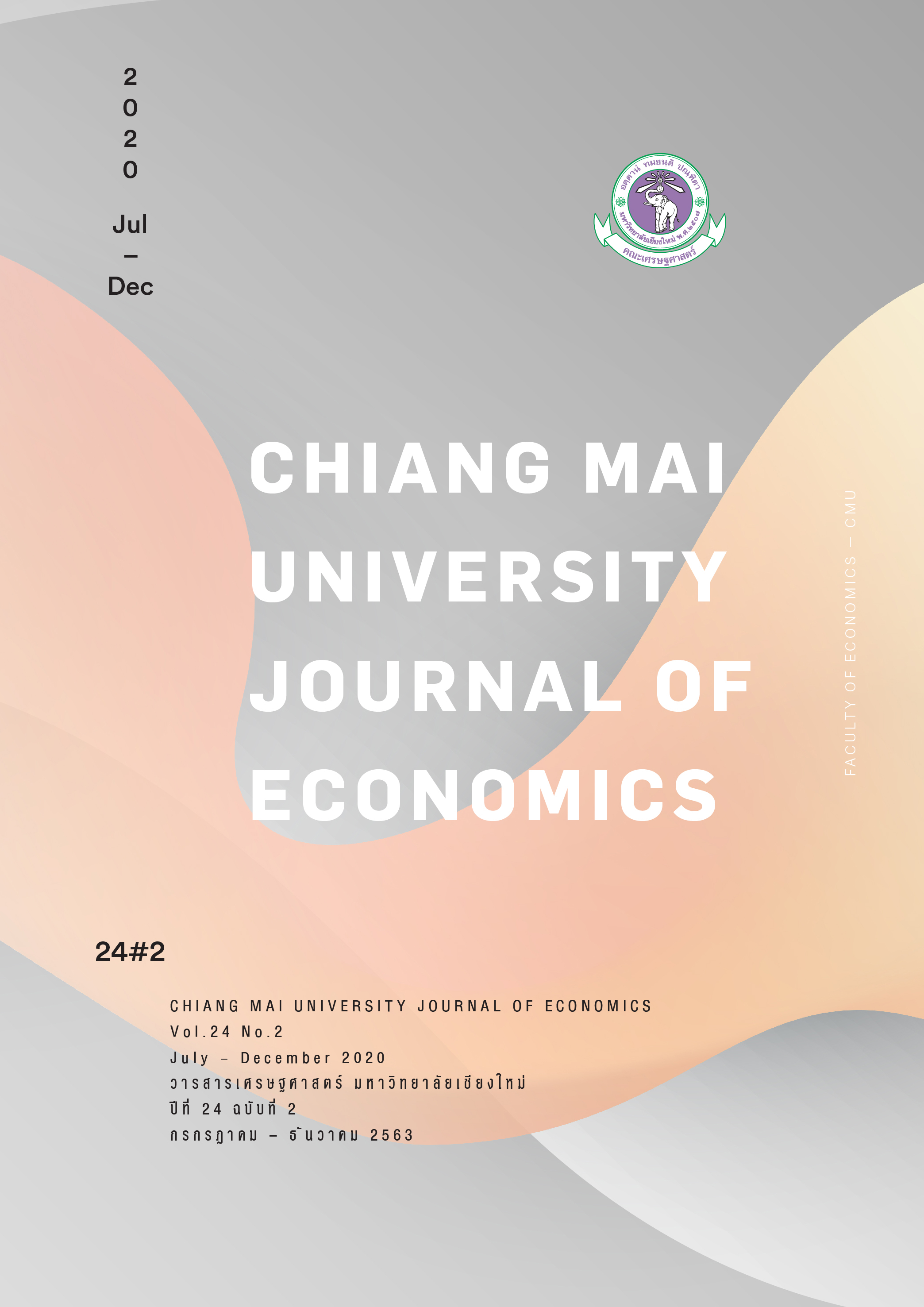Household Structure and Poverty of Thai Older Persons
Keywords:
household structure/ poverty/ older personsAbstract
This study aims to study the relationship between household structure and poverty of Thai older persons. It is a quantitative study, using the secondary data of private consumption level of older persons from a previous study on intergenerational economic transfer in Thailand 2017 and the dataset of Household Social-Economic Survey 2017. The study population are all Thai older persons aged 60 years and over. According to the findings, by comparing the private consumption level of older persons with the poverty line in 2017 (2,686 baht per month), approximately 6.6 percent of the total older persons was found living under the poverty line or in poverty. Considering the household structure of older persons (classified by household members composition by age groups), the analysis found that the older persons whose household structured with the working-ages and children were most likely to live in poverty. This was followed by the older persons whose household structured with only the working ages, with only older persons, with older persons and children and older person living alone, respectively. Other factors significantly associated with the poverty of older persons included age, education level, marital status, work status, disability, household head position, region of residence, area of residence, household debt, receiving old-age allowance, and health insurance. From these findings, it is suggested that apart from measures to directly support the older persons, the involving policy agencies should be aware of the importance and consider measures to support the working ages in older persons’ household. The measures, such as tax reduction, should aim to lessen the living expenses both directly and indirectly of the working-age who lived with older persons to enable them to have more capacity to support dependents in the household.
References
ชำนาญ แตงทอง. (2543). ความมั่นคงทางด้านเศรษฐกิจของผู้สูงอายุในเขตชนบท จังหวัดสุพรรณบุรี. นครปฐม: มหาวิทยาลัยมหิดล.
ดิเรก ปัทมสิริวัฒน์ และสุวิมล เฮงพัฒนา. (2557). การออม ความมั่งคั่ง และบำนาญผู้สูงอายุของครัวเรือนไทย. สำนักวิจัย สถาบันบัณฑิตพัฒนบริหารศาสตร์.
ดิเรก ปัทมสิริวัฒน์, สุวิมล เฮงพัฒนา, และ พุดตาน พันธุเณร. (2557). การลงทุนในเด็กของครัวเรือนไทย . วารสารเศรษฐศาสตร์และนโยบายสาธารณะ .
ธนพล สราญจิตร์. (2558). ปัญหาความยากจนในสังคมไทย . วารสารวิชาการมหาวิทยาลัยอีสเทิร์นเอเชีย ฉบับสังคมศาสตร์และมนุษยศาสตร์ , 12-21.
ธนานนท์ บัวทอง, และวรเวศม์ สุวรรณระดา. (2555). การเปลี่ยนแปลงโครงสร้างอายุของสมาชิกครัวเรือน กับรูปแบบการบริโภคของครัวเรือนไทย . วารสารมนุษยศาสตร์และสังคมศาสตร์ มหาวิทยาลัยอุบลราชธานี , 26-44.
ธนานนท์ บัวทอง. (2560). การศึกษาการเปลี่ยนแปลงโครงสร้างทางประชากรกับรูปแบบการบริโภคของครัวเรือนไทย. กรุงเทพมหานคร: จุฬาลงกรณ์มหาวิทยาลัย.
ปราโมทย์ ประสาทกุล และปัทมา ว่าพัฒนวงศ. (2553). นิยามผู้สูงอายุว่าด้วยช่วงชีวิตข้างหน้า. ประชากรและสังคม 2553 (หน้า 15-26). นครปฐม: สถาบันวิจัยประชากรและสังคม.
ปัทมา ว่าพัฒนวงศ์. (2562). การอยู่อาศัยร่วมกันของสมาชิกครัวเรือนไทย พ.ศ. 2539 - 2560: การจำแนกรูปแบบด้วยกลุ่มวัย. จงจิตต์ ฤทธิ์รงค์, ประชากรและสังคม 2562 (หน้า 37-49). นครปฐม: สถาบันวิจัยประชากรและสังคม มหาวิทยาลัยมหิดล.
พัชราวลัย วงศ์บุญสิน. (2553). การลดลงของอัตราเจริญพันธุ์: นัยต่อการปันผลทาง ประชากรระยะที่ 2 ของไทยยุคสังคมเสี่ยงภัย . วารสารประชากรศาสตร์ , 27-62.
วรวรรณ ชาญด้วยวิทย์. (2551). หลักประกันดานรายได้สําหรับผู้สูงอายุไทย. สถาบันวิจัยเพื่อการพัฒนาประเทศไทย.
วรเวศม์ สุวรรณระดา. (2549). แนวทางการสร้างหลักประกันด้านรายได้ของผู้สูงอายุ (บทเรียนจากประเทศญี่ปุ่น) . วารสารการงบประมาณ , 72-85.
วิทยากร เชียงกูล. (2547). พัฒนาการแบบยั่งยืนกับการแก้ปัญหาคนจน. กรุงเทพมหานคร: อมรินทร์พริ้นติ้งแอนด์พับลัชชิ่งจำกัด มหาชน.
วิพรรณ ประจวบเหมาะ, และ ชลธิชา อัศวนิรันดร. (2554). การเปลี่ยนแปลงทางประชากรและข้อมูลสถิติที่สําคัญเกี่ยวกับผู้สูงอาย. กรุงเทพมหานคร: สํานักพิมพ์พงษ์พาณิชย์เจริญผล.
สถาบันวิจัยประชากรและสังคม. (2560). สถานการณ์ผู้สูงอายุไทย พ.ศ. 2560. นครปฐม: สถาบันวิจัยประชากรและสังคมมหาวิทยาลัยมหิดล.
สำนักงานคณะกรรมการพัฒนาการเศรษฐกิจและสังคมแห่งชาติ. (2560). การคาดประมาณประชากรของประเทศไทย พ.ศ.2553-2583. กรุงเทพมหานคร: สำนักงานคณะกรรมการพัฒนาการเศรษฐกิจและสังคมแห่งชาติ.
สำนักงานคณะกรรมการพัฒนาการเศรษฐกิจและสังคมแห่งชาติ. (2560). รายงานการวิเคราะห์สถานการณ์ความยากจนและความเหลื่อมล้ำในประเทศไทย. กรุงเทพมหานคร: สำนักพัฒนาฐานข้อมูลและตัวชี้วัดภาวะสังคม.
สำนักงานสถิติแห่งชาติ. (2557). ผู้สูงอายุไทย. กรุงเทพมหานคร: สำนักงานสถิติแห่งชาติ.
สำนักงานสถิติแห่งชาติ. (2561). การสํารวจการเปลี่ยนแปลงของประชากร. กรุงเทพมหานคร: สำนักงานสถิติแห่งชาติ.
สุทธิชัย จิตะพันธ์กุล. (2544). Active ageing เรือธงลำใหม่ในศตวรรษที่ 21. วารสารพฤฒาวิทยาและเวชศาสตร์ผู้สูงอายุ, 1-3.
สุทธิพงศ์ บุญผดุง. (2554). การพัฒนาคุณภาพชีวิตผู้สูงอายุในท้องถิ่นโดยใช้โรงเรียนเป็นฐาน ตามหลักเศรษฐกิจพอเพียง (ระยะที่ 1). กรุงเทพมหานคร: มหาวิทยาลัยราชภัฏสวนสุนันทา.
สุภาภรณ์ คำเรืองฤทธิ์. (2556). การเตรียมความพร้อมเพื่อวัยสูงอายุทางประชากรไทย. วารสารประชากรศาสตร์ , 53-83.
สุวิณี วิวัฒน์วานิช, จิราพร เกศพิชญวัฒนา, และรัชพันธุ์ เชยจิตร. (2551). โครงการสถานการณ์ความยากจนในผู้สูงอายุและรูปแบบการจัดการเพื่อส่งเสริมการมีคุณภาพชีวิตของผู้สูงอายุไทย. กรุงเทพมหานคร: สำนักงานกองทุนสนับสนุนการวิจัย (สกว.).
อนันท์ชนก สกลธนวัฒน. (2554). โครงการศึกษาพลวัตของความยากจน : กรณีศึกษาครัวเรือน ชาวนาในพื้นที่เขตชนบทภาคตะวันออกเฉียงเหนือและภาคกลางของไทย. กรุงเทพมหานคร: สำนักงานสนับสนุนกองทุนวิจัย.
อารี จำปากลาย. (2552). เมื่อต้องเติบใหญ่ห่างไกลพ่อแม่: ลูกของพ่อแม่ที่ย้ายถิ่น ในมุมมองปู่ย่าตายาย. นครปฐม: สถาบันวิจัยประชากรและสังคม มหาวิทยาลัย.
Albert, A, & Modigliani, F. (1963). The Life – Cycle Hypothesis of saving: aggregate implications and tests. American Economic Review, 53(1), 55-84.
Bloom, D., Mitgang, E. and Osher, B. (2016). Demography of Global Aging. IZA Discussion Paper .
Cao, F. (2019). Elderly Care, Intergenerational Relationships and Social Change in Rural China.
Chen, Y., and Chen, C. (2012). Living Arrangement Preferences of Elderly People in Taiwan as Affected by Family Resources and Social Participation. Journal of Family History.
Cox, D., and Mark R. (1992). Inter-vivos Transfers and Intergenerational Exchange. The Review of Economics and Statistics.
Ofstedal, M. B., Reidy, E., & Knodel, J. (2004). Gender differences in economic support and well – being of older Asian. Journal of Cross – Cultural Gerontology, 19, 165 – 201.
Teerawichitchainan, B., Pothisiri, W., and Giang Thanh Long. (2015). How do living arrangements and intergenerational support matter for psychological health of elderly parents? Evidence from Myanmar, Vietnam, and Thailand. Social science & medicine, 106-116.
Tinson, A., Ayrton C., Barker, K., Aldridge, H. and Peter Kenway. (2016). Monitoring Poverty and Social Exclusion (MPSE). Publications INCOME AND POVERTY.
United Nations. (2013). Measuring and Analysing the Generational Economy: National Transfer Accounts Manual. New York: United Nations.
Williams, C. (2010). Women in Canada: A Gender-based Statistical Report. Statistical Canada Catalogue.
Downloads
Published
Issue
Section
License
All opinions and contents in the CMJE are the responsibility of the author(s). Chiang Mai University Journal of Economics reserves the copyright for all published materials. Papers may not be reproduced in any form without the written permission from Chiang Mai University Journal of Economics.
ข้อคิดเห็นที่ปรากฏและแสดงในเนื้อหาบทความต่างๆในวารสารเศรษฐศาสตร์มหาวิทยาลัยเชียงใหม่ ถือเป็นความเห็นและความรับผิดชอบโดยตรงของผู้เขียนบทความนั้นๆ มิใช่เป็นความเห็นและความรับผิดชอบใดๆของวารสารเศรษฐศาสตร์ มหาวิทยาลัยเชียงใหม่
บทความ เนื้อหา และข้อมูล ฯลฯ ในวารสารเศรษฐศาสตร์มหาวิทยาลัยเชียงใหม่ ถือเป็นลิขสิทธิ์เฉพาะของคณะเศรษฐศาสตร์มหาวิทยาลัยเชียงใหม่ หากบุคคลหรือหน่วยงานใดต้องการนำทั้งหมดหรือส่วนหนึ่งส่วนใดไปเผยแพร่ต่อหรือเพื่อกระทำการใดๆ จะต้องได้รับอนุญาตเป็นลายลักษณ์อักษร จากวารสารเศรษฐศาสตร์ มหาวิทยาลัยเชียงใหม่






